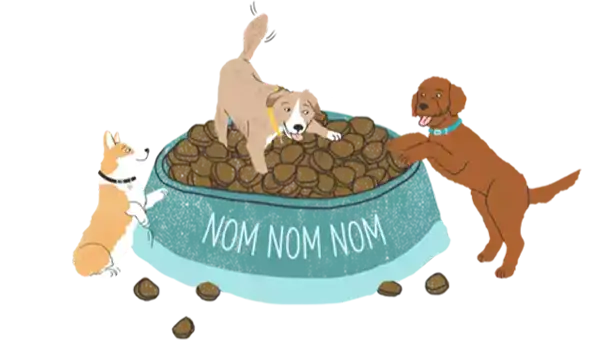You will likely need to change your dog's regular food at various times throughout their life. This may be when you switch from puppy to adult to senior dog food formulas, to address potential food allergies or sensitivities, or even due to health issues. There may even be times when your usual food isn't available. Changing your dog's food may seem simple enough, but it can cause stomach and intestinal upset. You can make the switch easier on your furry friend with a few easy steps.
When to Change Your Dog’s Food
Life stage transitions
Unless you're feeding your dog a food classified as "all life stages (which you should not be feeding an adult or senior dogs)," you will need to change it when they transition from puppy to adult, and possibly again when they transition from adult to senior. Puppy food has a higher calorie count and often a different formula to support a growing puppy's high metabolism and nutritional needs. When your puppy matures into an adult, they no longer need high-calorie food. Changing their food prevents your dog from becoming overweight.
The same goes for when your adult dog becomes a senior; senior dogs have slower metabolisms than adult dogs and do not require as many calories. Senior dog foods also often include nutritional supplements to support an aging body. They also have lower levels of minerals that could put more stress on things such as their kidneys.
The timing of changing your dog's food from puppy to adult formula depends on their size and breed, which dictates when they reach maturity and stop growing. In general, you should feed puppy food until your dog is a year old. Ask your veterinarian for more specifics on when to transition your puppy’s food to the adult formula.
Switching from adult to senior dog food formula usually happens around six to nine years of age.
Health issues
Certain medical issues like diabetes, kidney disease, liver disease, heart disease, gastrointestinal disease, canine cognitive dysfunction, urinary disease, and others require changing your dog's diet from regular to prescription dog food. If you're changing your dog's food to a prescription formula, speak with your veterinarian about the timing of this change.
If your veterinarian suspects that your dog is particularly sensitive or allergic to certain ingredients, you will most likely need to try one or more dog foods to find the best one for your dog. Talk to your veterinarian about this food change as many of the over-the-counter novel protein diets contain cross contamination.
Product availability and price changes
Supply chain issues can lead to your dog's regular food being out of stock or discontinued altogether. Or the dog food manufacturer may issue a recall for your dog's regular food.
You may also notice price increases, especially if the protein source is in high demand. This can mean switching your dog's food based on availability or budget concerns.
Your dog's preferences
Every dog has their preferences — some may prefer fish over beef. Your dog may simply not enjoy the dog food you picked out for them, or their tastes may have changed over time. They may also have different texture preferences. Just make sure that they aren't refusing food due to dental pain or other medical issues before changing their food so be sure to speak with your veterinarian.
How to Change Your Dog's Food
Changing your dog's food should happen gradually, over at least one week. For dogs with a particularly sensitive stomach or those who are picky eaters, you may want to extend this food transition to two weeks.
For many dogs, a sudden food switch can cause stomach aches, diarrhea, or vomiting, leading to dehydration. A dog's gut microbiome is acclimated to a particular food formula, so if the protein, carbohydrates, or other main ingredients are suddenly changed, it has a hard time breaking down those new ingredients. It takes time to recalibrate their system.
Here's a sample schedule for changing your dog's food:
Day 1-2: 75% old food mixed with 25% new food
Day 3-5: 50% old food mixed with 50% new food
Day 6-7: 25% old food mixed with 75% new food
Day 8+: 100% new food
Another option is to use the new food as part of your dog's daily training treats.
The process is the same for switching from dry dog food to wet.
If you're switching to a prescription diet or another food recommended by your veterinarian, discuss the transition schedule with them. In certain emergencies, they may recommend an immediate change. This is generally only necessary if there's a serious medical issue and the benefits of the new food urgently outweigh the risks of transitioning slowly.
Monitor your dog throughout the food transition. If you notice diarrhea or vomiting, reduce the amount of new food you mix in and extend the length of the food change schedule. You may also consider adding probiotics to your dog's diet. Speak with your veterinarian about their recommendations.
ZPC-02525



